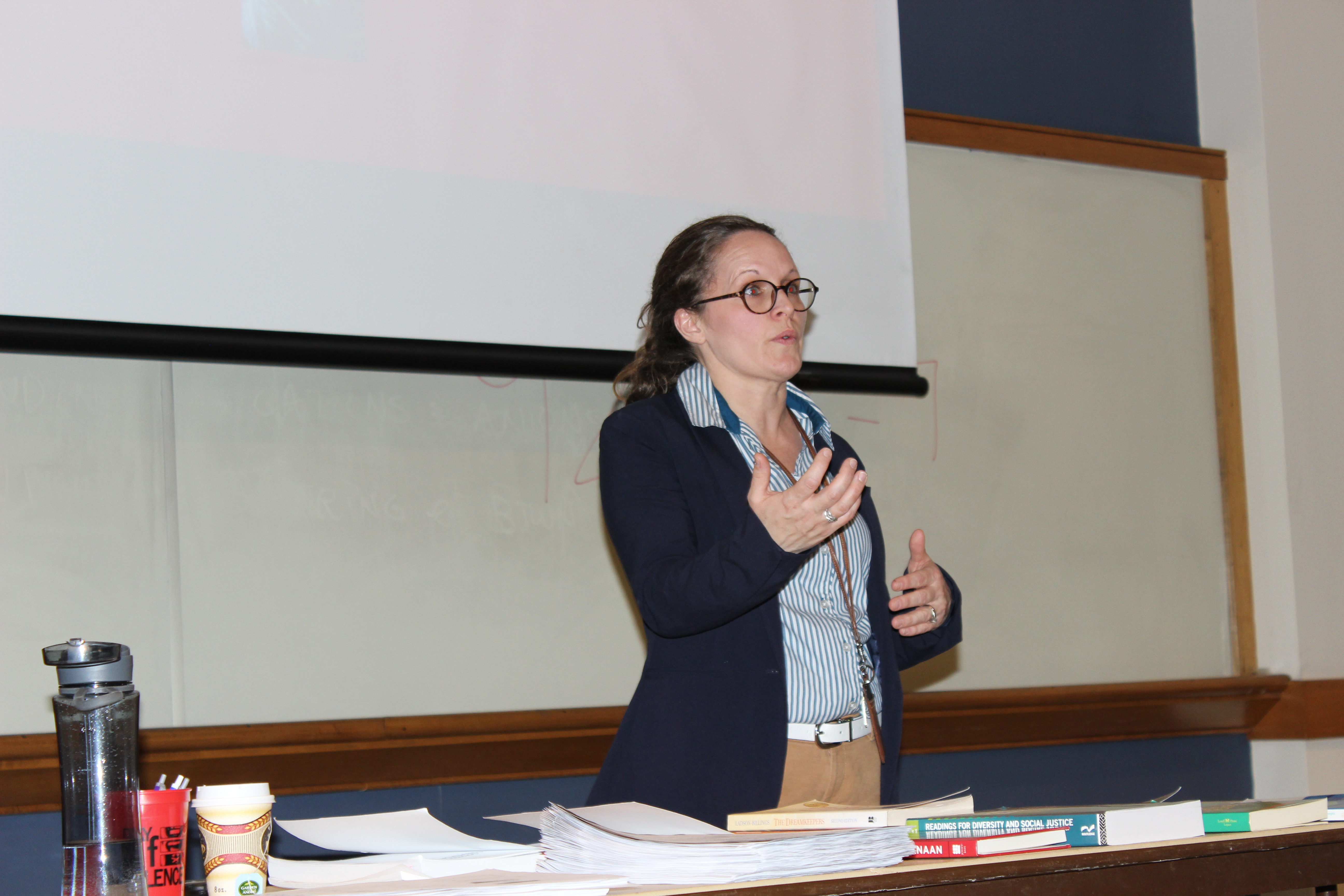
Ayanna Totten
Staff Writer
Royd McCoy, a 6-foot-2-inch male student, flipped his desk and cursed at Dr. Laura Kieselbach. Kieselbach, who is just under 5 feet, hid her terror with anger.
The incident occurred during her first few weeks as a teacher, when she had a limited arsenal of classroom management skills. McCoy wouldn’t stop talking during a vocabulary test, causing Kieselbach to rip his exam and throw him out the class.
In a later conversation, she would learn McCoy faced greater troubles at home. His mother was dead, his father was in jail and he was being raised by an aunt with an autistic son.
“It dawned on me that this kid’s life and his experiences and his learning looks nothing like mine,” said Kieselbach. “So, I needed to stop assuming that every kid could come in and take the test because I said so…I started reconsidering what it meant to reach every student.”
Now an assistant professor of English, she shared her research in a Culturally Relevant Teaching presentation in Beers Lecture Hall on Nov. 29.
Despite battling a raspy and waning voice under the treatment of chamomile tea, Kieselbach curated an open dialogue among faculty. Attendees explored how they could create a culturally responsive environment in their classrooms and across campus.
Culturally relevant teaching recognizes the values, prior experiences and cultural knowledge of students, and a culturally responsive environment focuses on how a university responds to diversity.
Kieselbach began her presentation with the nine culturally relevant teaching principles listed in Gloria Ladson-Billings’ 1994 book, “The Dreamkeepers.” Some include: cultural sensitivity, reshaping the curriculum and active teaching methods.
In the first workshop activity, Kieselbach asked the audience to form small teams and brainstorm how they might apply the principles in their classroom or course.
Dr. Holly Wells emphasized the power of using stories to relate to students. Christopher Dudley stated even ensuring students know how to upload an assignment to D2L is important; teachers can’t assume all college students are technologically savvy.
Assistant Director of Admissions Agnes Brannan also explained how the university’s application process exposes her and her colleagues to different cultures. Some applicants might not have internet access, and the admissions staff must then provide the appropriate services for their success.
For the second activity, Kieselbach asked attendees to assess whether ESU’s school environment is culturally responsive.
Kieselbach kicked off the conversation with a broader viewpoint. She mentioned that during the holiday season, there are many Christmas trees on campus but little acknowledgement of other celebrations, such as Kwanzaa and Hanukkah.
Marcia Prince-Cuffe delved a little deeper and addressed the lack of diversity in “the face of our faculty.”
“I know a lot of my colleagues…women of color in particular, who are doing a tremendous amount of stuff to care for students that is great, but that’s also not really their job, and it’s putting a tremendous burden on them,” said Dudley.
Dr. Stephanie McCall stated: “Everybody has to go beyond what it looks like it is, in consideration of what are the relations of power involved…I think it also requires an analysis of how are decisions made, what knowledge is most valued, what disciplines have higher priority, who gets more funding. Those are all relations of dominance around being culturally responsive.”
Eugene Kelly, a former employee at Lafayette College, discussed socioeconomic factors. He explained that Lafayette’s cost of attendance is over $70,000, but less than half of students receive aid.
ESU teachers might have to consider how textbook choices could affect students. “Do I really need that book? Do I really need the D2L integration, or can I go with this general psych textbook that’s free?” Kelly questioned.
Kieselbach stepped outside the box with the third activity, “Unpack Your Suitcase,” an exercise she does with her students. She instructed the audience to share the physical items and intangible ideas they carry every day.
“The guilt of my profession,” revealed University Police Chief William Parrish, who hopes to recruit more African-Americans.
“On a regular basis, you see police brutality or police misconduct, which is very blatant in a lot of circumstances. The million other cops that are watching it on television are saying the same thing. Unfortunately, we’re all sort of labeled. And to a certain extent, rightfully so,” Parrish continued.
Although Kieselbach wouldn’t consider herself an expert, she admits she’s “a passionate scholar practitioner who’s always trying to learn more.”
“Just saying the terms or thinking that you’re doing it [culturally relevant teaching] isn’t enough,” said Kieselbach. She understands change happens slowly, but she believes it’s possible if people remain persistent.
“I hope they [attendees] took away from this that changes and gestures don’t have to be grand,” said Kieselbach.
“And sometimes it’s not even what happens in the classroom, but meeting with the kid after and approaching a topic in a different way that connects with them. So, hopefully they’re a little bit more willing and a little bit more open, if nothing else, to reflect on their own practices.”
Kieselbach concluded the presentation with another opportunity to do just that. She invited faculty members to attend the fifth Culturally Responsive Teaching and Learning Program (CRT-L) Conference in Baltimore, Md. from March 20-22.
Email Ayanna at:
atotten@live.esu.edu

